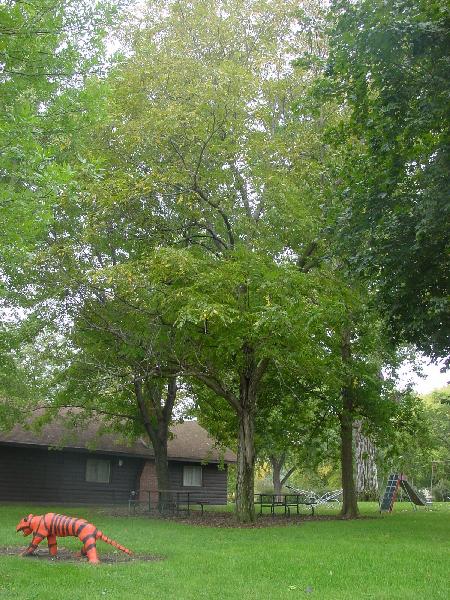Butternut Tree Biography
Butternut trees are native to the United States. They are slow growing and seldom live more than 75 years.
Butternut trees are being killed off by Butternut canker. In addition, the Butternut is very susceptible to fire damage and intolerant to shade. It is considered to be "threatened" in Tennessee; "exploitably vulnerable" in New York and of "special concern" in Kentucky. April 13, 2005.
Branch of Butternut with leaves and catkins. Flowering occurs from April to June. The Butternut tree is monoecious with female (pistillate) and male (staminate) flowers appearing on the same tree, but not usually opening at the same time. The flowers are borne on pendulous catkins - with male and female flowers on separate catkins. Notice the hairy "moustache like" pad above the leaf scar. Some people call it eyebrows for the "monkey face" shaped leaf scar. April 13, 2005
Photo showing branch of Juglans cinerea L. with leaf scars, bundle scars, lenticels and buds. April 13, 2005
Male flowers (catkins) of Butternut tree. May 15, 2008
The Butternut tree has compound leaves that are 15 - 30 inches long. Generally 11-17 leaflets with terminal leaflet is present. The leaflets are nearly sessile (don't have stalks) and are attached to a stout, hairy rachis. The leaves are hairy above and below and have fine sharp teeth. June 04, 2006
The terminal bud is irregularly oblong and somewhat flattened. Lateral buds are ovoid and much smaller. Lateral buds are generally superposed. The young twigs, stems, leaflets and fruit have hairs Photo taken July 23, 2006
The fruit of the Butternut is nearly twice as long as it is wide. It is covered with hairs that are sticky and oily to the touch. Fruits are single or in clusters of 2-5, with a hard, thick, deeply furrowed shell enclosed by a thick husk. The fruit of the Butternut ripens in September or October and may stay on the tree until after the leaves fall.
Butternut fruit provides food for squirrels and other rodents and the leaves are palatable to white-tailed deer. The nuts are used in baking and, in New England, for maple-butternut candy..
Butternut trees are native to the United States. They are slow growing and seldom live more than 75 years.
Butternut trees are being killed off by Butternut canker. In addition, the Butternut is very susceptible to fire damage and intolerant to shade. It is considered to be "threatened" in Tennessee; "exploitably vulnerable" in New York and of "special concern" in Kentucky. April 13, 2005.
Branch of Butternut with leaves and catkins. Flowering occurs from April to June. The Butternut tree is monoecious with female (pistillate) and male (staminate) flowers appearing on the same tree, but not usually opening at the same time. The flowers are borne on pendulous catkins - with male and female flowers on separate catkins. Notice the hairy "moustache like" pad above the leaf scar. Some people call it eyebrows for the "monkey face" shaped leaf scar. April 13, 2005
Photo showing branch of Juglans cinerea L. with leaf scars, bundle scars, lenticels and buds. April 13, 2005
Male flowers (catkins) of Butternut tree. May 15, 2008
The Butternut tree has compound leaves that are 15 - 30 inches long. Generally 11-17 leaflets with terminal leaflet is present. The leaflets are nearly sessile (don't have stalks) and are attached to a stout, hairy rachis. The leaves are hairy above and below and have fine sharp teeth. June 04, 2006
The terminal bud is irregularly oblong and somewhat flattened. Lateral buds are ovoid and much smaller. Lateral buds are generally superposed. The young twigs, stems, leaflets and fruit have hairs Photo taken July 23, 2006
The fruit of the Butternut is nearly twice as long as it is wide. It is covered with hairs that are sticky and oily to the touch. Fruits are single or in clusters of 2-5, with a hard, thick, deeply furrowed shell enclosed by a thick husk. The fruit of the Butternut ripens in September or October and may stay on the tree until after the leaves fall.
Butternut fruit provides food for squirrels and other rodents and the leaves are palatable to white-tailed deer. The nuts are used in baking and, in New England, for maple-butternut candy..
Butternut Tree
Butternut Tree
Butternut Tree
Butternut Tree
Butternut Tree
Butternut Tree
Butternut Tree
Butternut Tree
Tapping A Butternut Tree
Butternut Trees








No comments:
Post a Comment